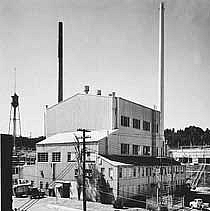Iodine-131 Releases

The Clinton Pile Building, later known as the Graphite Reactor, was located at the X-10 site, now referred to as the Oak Ridge National Laboratory (ORNL).
Public Health Assessment
- Iodine-131 Releases [PDF, 2 MB]
To address the community’s concerns, the Agency for Toxic Substances and Disease Registry (ATSDR) conducted a public health assessment (March 2008) [PDF, 2 MB] to evaluate whether past, current, and potential future releases of iodine-131 (I-131) from the ORR could harm people living near the reservation. Drinking backyard goat’s and cow’s milk was determined to be the primary way in which people who lived near the ORR could have come in contact with I-131.
After reviewing the current literature, ATSDR concluded that individuals who were living near the ORR and who were at least 21 years of age* during the initial years of RaLa processing (1944 - 1956) were not exposed to I-131 at levels that would have induced thyroid diseases, including thyroid cancer. However, because of limitations with the available data, ATSDR is unable to reach a definitive conclusion regarding the potential for I-131-related health effects to occur in the critical, sensitive population—those individuals who were under age 18,* who lived near the ORR during the years of RaLa processing, and who may have received a thyroid radiation dose in excess of 10 rads.
Additionally, recently discovered historical air monitoring data from the early and mid-1950s and deer thyroid data from 1979 to 1989 suggest that I-131 released into the air from RaLa processing did not extend beyond the X-10 site boundary at levels that would constitute a public health hazard.
ATSDR does not expect any current or future exposures to I-131 from the X-10 site. Since 1991, no significant amounts of I-131 have been released to the air from the ORR. Any historical I-131 released from the X-10 site during the 1940s through 2005 has decayed completely or is currently not present in the ORR area at levels that pose a health hazard.
*The literature regarding health effects is inconclusive for individuals 18 to 20 years of age.
Contact Us:
- Agency for Toxic Substances and Disease Registry
4770 Buford Hwy NE
Atlanta, GA 30341-3717 USA - 800-CDC-INFO
(800-232-4636)
TTY: (888) 232-6348
Email CDC-INFO - New Hours of Operation
8am-8pm ET/Monday-Friday
Closed Holidays


